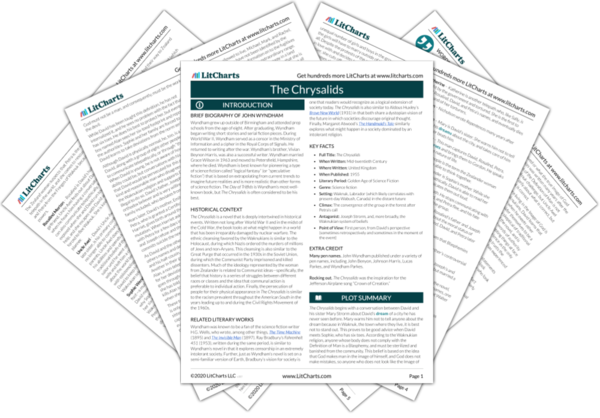Words
Words and language are at the heart of The Chrysalids because it is David’s ability to communicate wordlessly that makes him a Blasphemy. This ability frightens the leaders of Waknuk not only because David might be able to plan a secret uprising against them, but also because David’s existence challenges the authority of the words on which the leaders’ power is based. By classifying David as a Blasphemy, however, the leaders of Waknuk contradict…
read analysis of WordsWays of Knowing
The citizens of Waknuk rely mostly on tradition and religious texts as sources of knowledge about the world. Myths about the dangers of the Fringes and the Badlands proliferate, but Uncle Axel tells David that when explorers went to these areas, they found that these myths were not always true. Unlike most people in Waknuk, Uncle Axel frequently questions statements that are presented as fact. He points out that there is no way of being…
read analysis of Ways of KnowingTime and Progress
The title of Wyndham’s book introduces time as an important theme in the novel because the word “chrysalid” implies a specific sense of time. The word can either mean “a shell that has been discarded” or “a preparatory or transitional state”—it is either something in the past or something preparing for the future. Because Wyndham never uses the word anywhere in the text of the novel, however, it is not clear precisely to what or…
read analysis of Time and Progress
Morality
While Wyndham’s novel is not necessarily optimistic about the future of this post-apocalyptic world, the book does not take an entirely negative stance on the future of society. Instead, the book argues that even within societies that are morally corrupt, individuals have the power and responsibility to make their own moral choices. Indeed, while the actions of the Waknukians and Zealanders are morally reprehensible due to their racist and violent nature, certain people within these…
read analysis of MoralityRacism and Fear of the Unknown
Waknuk operates under a set of laws and beliefs that discriminates against anyone or anything that does not look “normal.” Those who appear different in any way from the Image of God as prescribed by the Definition of Man are segregated from society and sterilized, so that they cannot produce more Deviations. The Chrysalids exposes the hypocrisy and ludicrousness of any society that kills its members in an attempt to be more pure and moral…
read analysis of Racism and Fear of the UnknownReal World Allegory
Wyndham wrote The Chrysalids in the 1950s, after the atrocities of World War II and in the midst of the Cold War, and the ideologies espoused by the Waknukians and the Zealanders are similar to those of real-world groups at that time. The Waknukian’s insistence on racial purity is similar to that of the Nazis, while the decision to segregate Blasphemies into a specific area is reminiscent of both Nazi concentration camps and the racially-driven…
read analysis of Real World Allegory






